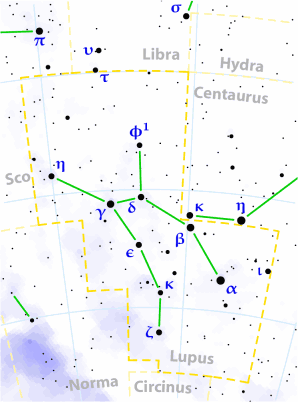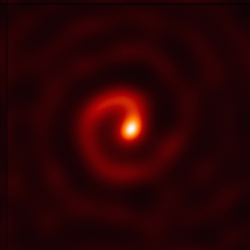http://apod.nasa.gov/apod/ap090801.html
------------------------------------------------------
http://en.wikipedia.org/wiki/Walpurgis_Night wrote:
<<Walpurgisnacht is a traditional religious holiday of pre-Christian origin, celebrated today by Christian and non-Christian communities as well, on April 30 or May 1 in large parts of Central and Northern Europe. Historically Walpurgisnacht is derived from various pagan spring customs. Bonfires were built to keep away the dead and chaotic spirits that were said to walk among the living then. This is followed by the return of light and the sun as celebrated during May Day. The current festival is in most countries celebrating it named after Saint Walpurga, born in Devon about 710. Walpurga was honored in the same way that Vikings had celebrated spring and as they spread throughout Europe, the two dates became mixed together and created the Walpurgis Night celebration. Early Christianity had a policy of 'Christianising' pagan festivals so it is perhaps no accident that St. Walpurga's day was set to May 1.>>
- ----------------------------------------------------
<<Son of Erik the Red, Leif Erikson discovered and settled Vinland/Newfoundland around the year 1003 AD. The settlement which is now known as L’Anse aux Meadows. Conflicts with the natives arose around 1006 AD. The natives eventually drove the Vikings off.>>
------------------------------------------------------
http://en.wikipedia.org/wiki/SN_1006 wrote:
<<SN 1006 was a supernova, widely seen on Earth beginning in the year 1006 CE; Earth was about 7200 light-years away from the supernova. It was the brightest apparent magnitude stellar event in recorded history. First appearing in the constellation of Lupus between April 30 and May 1 of that year, this "guest star" was described by observers in China, Egypt, Iraq, Japan, Switzerland, and possibly North America.
. Historic description
The Chinese and Arabic astronomers have left the most complete historical descriptions of the supernova.
The Egyptian Arabic astronomer and astrologer Ali ibn Ridwan, writing in a commentary on Ptolemy's Tetrabiblos, said that the object was 2.5 to three times as large as the disc of Venus, and about one-quarter the brightness of the Moon; like all other observers, says that the star was low on the southern horizon. Monks at the Benedictine abbey at St. Gallen broadly corroborate bin Ridwan's observations as to magnitude and location in the sky, additionally writing that "n a wonderful manner this was sometimes contracted, sometimes diffused, and moreover sometimes extinguished." This last is often taken as proof that the supernova was of Type Ia. Some sources state that the star was bright enough to cast shadows; it was certainly seen during daylight hours for some time, and the modern-day astronomer Frank Winkler has said that "in the spring of 1006, people could probably have read manuscripts at midnight by its light."
The reports from Switzerland are particularly noteworthy, as the supernova would have been very low in the sky there, rising to at most 5 degrees above the southern horizon and being visible for only 4-5 hours at a time. Atmospheric extinction and the need to find a site with a clear southern horizon make seeing even bright objects this low difficult; the "sometimes contracted, diffused, extinguished" remarks quoted above hint at atmospheric effects caused by the low apparent altitude of the object.
According to Songshi in the section of 56 and 461, the star was seen on May 1, 1006 which appeared to the south of constellation Di, east of Lupus and one degree to the west of Centaurus. The size of the visual explosion was half that of the moon, and shone so brightly that objects on the ground could be seen at night. By December, it was again sighted in the constellation Di. The Chinese astrologer Zhou Keming, who was on his return to Kaifeng from his duty in Guangdong, interpreted the star to the emperor on May 30 as an auspicious star, yellow in color and brilliant in its brightness, that would bring great prosperity to the state over which it appeared.
There appear to have been two distinct phases in the early evolution of this supernova. There was first a three-month period at which it was at its brightest; after this period it diminished, then returned for a period of about eighteen months. Most astrologers interpreted the event as a portent of warfare and famine.
A petroglyph by the Hohokam has been discovered in White Tank Mountain Regional Park which may be the first known North American representation of the supernova.
. Remnant
The associated supernova remnant from this explosion was not identified until 1965, when Doug Milne and Frank Gardner used the Parkes radio telescope to demonstrate that the previously known radio source PKS 1459-41, near the star Beta Lupi, had the appearance of a 30-arcminute circular shell.
Over the next few years, both X-ray and optical emission from this remnant were also detected. The supernova remnant of SN 1006 has an estimated distance of 2.2 kiloparsecs, making it approximately 20 parsecs in diameter. As expected for the remnant of a Type Ia supernova, no associated neutron star or black hole has been found.>>
------------------------------------------------------
http://en.wikipedia.org/wiki/Lupus_(constellation) wrote:
<<Lupus is a constellation in the southern sky. Its name is Latin for wolf. In ancient times, the constellation was considered an asterism within Centaurus, and was considered to have been an arbitrary animal, killed, or about to be killed, on behalf of, or for, Centaurus. It was not separated from Centaurus until Hipparchus of Bithynia named it Therion (meaning beast) in the 200s BC. No particular animal was associated with it until the Latin translation of Ptolemy's work identified it with the wolf.
Most of the brightest stars in Lupus are massive members of the nearest OB association: Scorpius-Centaurus. Towards the north of the constellation are globular clusters NGC 5824 and NGC 5986, and close by the dark nebula B 228. Two open clusters are to the south of the constellation, NGC 5822 and NGC 5749. On the western border are two spiral galaxies and the Wolf-Rayet planetary nebula IC 4406, containing some of the hottest stars in existence. Another planetary nebula, NGC 5882, is towards the centre of the constellation. The transiting exoplanet Lupus-TR-3b lies in this constellation.>>
-------------------------------------




